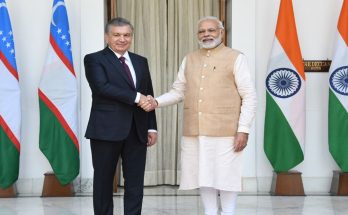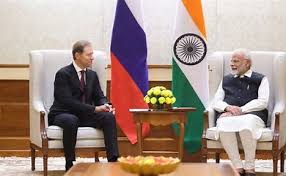 India and the US have temporarily resolved their disagreement regarding the Trade Facilitation Agreement (TFA) at the WTO. The US has consented to give India an indefinite ‘peace clause’ pending a permanent settlement of its food security problem. Earlier, Prime Minister Narendra Modi had declined to sign the significant TFA because the time allotted to India to rationalise food subsidies was only till 2017. WTO members agreed not to challenge India for breaking WTO rules on stockpiling until 2017. Under the latest agreement, however, the US has clarified that it and others won’t challenge India beyond 2017 if no solution is reached.
India and the US have temporarily resolved their disagreement regarding the Trade Facilitation Agreement (TFA) at the WTO. The US has consented to give India an indefinite ‘peace clause’ pending a permanent settlement of its food security problem. Earlier, Prime Minister Narendra Modi had declined to sign the significant TFA because the time allotted to India to rationalise food subsidies was only till 2017. WTO members agreed not to challenge India for breaking WTO rules on stockpiling until 2017. Under the latest agreement, however, the US has clarified that it and others won’t challenge India beyond 2017 if no solution is reached.
The change of stance of the US is significant because it wants to get ahead with the signing of the TFA at all costs, as it will greatly benefit the developed countries. It involves various measures taken by all governments which include improving port facilities, simplifying, modernising and harmonising rules for merchandise imports, improving customs procedures, port efficiency, customs administration and enforcement, transparency and corruption regulatory policies.
Basically, the TFA calls for strengthening the trade mechanism among the 159 signatories of the WTO which seems fair enough. But once a country signs the TFA, then all the commitments are binding and all disputes are subject to Dispute Settlement Mechanism of the WTO and it can lead to costly international litigations.
The TFA is universally claimed to be beneficial for the developing world, including India which lacks many items in trade facilitating infrastructure. But India already has initiated the process and is building new ports and modernising customs clearance stations along the borders. However, out of 138 land clearance stations that India has along its international border, only 66 are functional.
The TFA, however, is embroiled in controversy because trade facilitation, according to some scholars, will enhance the developed countries’ access to Indian markets and may impact manufacturing growth. Already we have been witnessing a sharp decline in manufacturing growth which has only recently picked up slightly. Manufacturing growth reached a high of 8 per cent from 2000-2010 but since then its performance has been worsening. It was minus 1.4 per cent in August 2014 and 2.5 per cent in September 2014, which can hardly be called high.
Studies have shown that India is losing out in competitiveness in all product lines and there has been a ‘hollowing out’ of industries. Exports of manufactured goods had doubled from 2005-2012, but imports too increased by 215 per cent. According to a Geneva based scholar, Rashmi Banga, there has been a steady decline in value addition growth in manufacturing, despite rise in output that represents ‘hollowing out’ of manufacturing industries. Value added in total manufacturing output declined from 25 per cent in mid 1990s to 18 per cent in 2010-11. Contribution of manufacturing to GDP is only 15 per cent as compared to 34 per cent by China. The National Manufacturing Policy 2013 aims at increasing the share to 25 per cent. If manufacturing growth does not pick up, employment growth in manufacturing sector, which is very important for absorbing the job seeking youth, will also slow down, creating problems in India’s utilising its ‘demographic dividend.’
Will the TFA be beneficial and lower trade costs so that manufacturers can import more raw materials and inputs? If India has better ports and efficient customs procedures and a single window clearance, India will surely attract more imports. As it is, cheap manufactured imports have been coming in aided by rapid increase in trade liberalisation and dismantling of protection. There will be a rise in import of consumer goods. With higher disposable incomes and rapid urbanisation, Indians want more consumer goods but as our own manufacturing growth has been faltering, it is but natural that China has filled the gap and has supplied India with increasing quantities of consumer goods. Import of consumer goods from China increased from 5.9 per cent in 2000 to 23.7 per cent in 2012. With the TFA, more Chinese imports will come in. According to one study, India’s imports will rise by $9 billion annually and exports will increase only by $2.6 billion. For all the developing countries, imports will increase by $84 billion while exports will increase only by $47 billion.
Should India go for TFA? Studies point out that it will increase global GDP by $ 1 trillion and will lead to drastic reduction in trade costs. Perhaps India has no choice because the US has relented to India’s demand. But in order to reap the benefits from all the improvements that the TFA calls for, Indian manufacturing should increase its competitiveness. India is known to have either very large or very small manufacturing units. There are few medium sized firms. Around 84 per cent of total manufacturing employment is in the small scale sector and only 6 per cent in small scale sector. The Small scale sector is characterised by low productivity, low technology and is affected by exchange rate fluctuations, environmental constraints, labeling and packaging requirements, lower cost competitiveness due to developed countries’ subsidies and increased pressure to comply with Intellectual Property Rights. It is true that the TFA will reduce the number of documents required and the number of days it takes for exports to reach their destination, but it cannot improve India’s manufacturing competitiveness.
The developed countries’ will continue to give huge subsidies to their agriculture and ease of entry into India will only facilitate imports of fresh food, giving tough competition to Indian farmers. Thus India has to negotiate for some measures that will lead to having a level playing field so that the TFA does not distort trade in favour of developed countries. Also, though the developing countries will have access to infrastructure loans from the New Development Bank of the BRICS, they should negotiate for technical collaboration and help from developed countries for infrastructure building and improvement. Greater market access for developing countries should be ensured because despite all such measures, there would still be non-tariff and para-tariff barriers which the developing countries will probably encounter while entering developed countries’ markets.
(The writer is a Senior Fellow at Observer Research Foundation, Delhi)
Courtesy: ORF
Author Profile
- India Writes Network (www.indiawrites.org) is an emerging think tank and a media-publishing company focused on international affairs & the India Story. Centre for Global India Insights is the research arm of India Writes Network. To subscribe to India and the World, write to editor@indiawrites.org. A venture of TGII Media Private Limited, a leading media, publishing and consultancy company, IWN has carved a niche for balanced and exhaustive reporting and analysis of international affairs. Eminent personalities, politicians, diplomats, authors, strategy gurus and news-makers have contributed to India Writes Network, as also “India and the World,” a magazine focused on global affairs.
Latest entries
 DiplomacyOctober 4, 2025UNGA Resolution 2758 Must Not Be Distorted, One-China Principle Brooks No Challenge
DiplomacyOctober 4, 2025UNGA Resolution 2758 Must Not Be Distorted, One-China Principle Brooks No Challenge India and the WorldJuly 26, 2025MPs, diplomats laud Operation Sindoor, call for national unity to combat Pakistan-sponsored terror
India and the WorldJuly 26, 2025MPs, diplomats laud Operation Sindoor, call for national unity to combat Pakistan-sponsored terror India and the WorldJuly 25, 2025When Fire Ends, Diplomacy Begins
India and the WorldJuly 25, 2025When Fire Ends, Diplomacy Begins India and the WorldJuly 16, 2025Operation Sindoor and its Aftermath: India’s Successful Diplomatic Outreach
India and the WorldJuly 16, 2025Operation Sindoor and its Aftermath: India’s Successful Diplomatic Outreach







